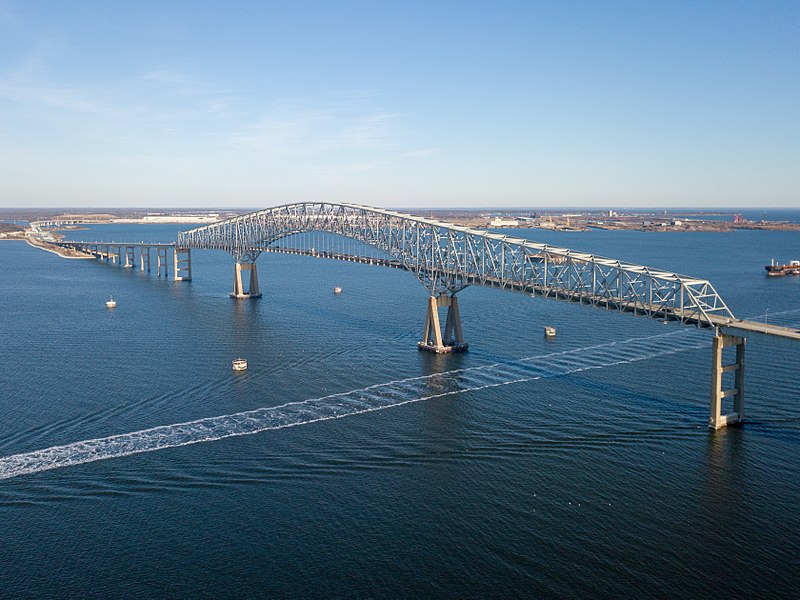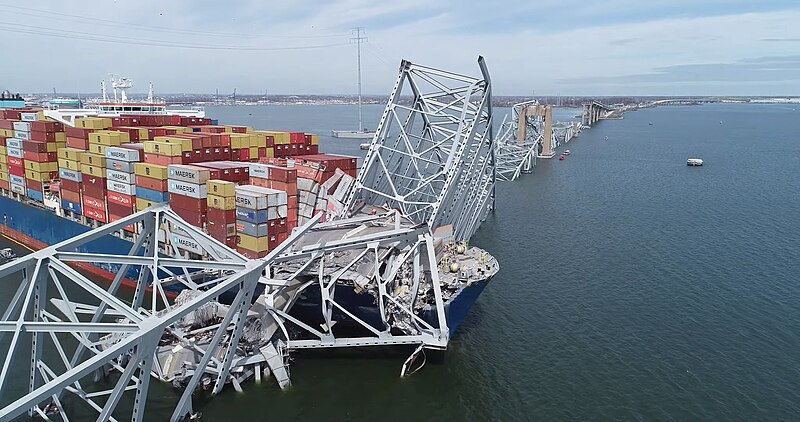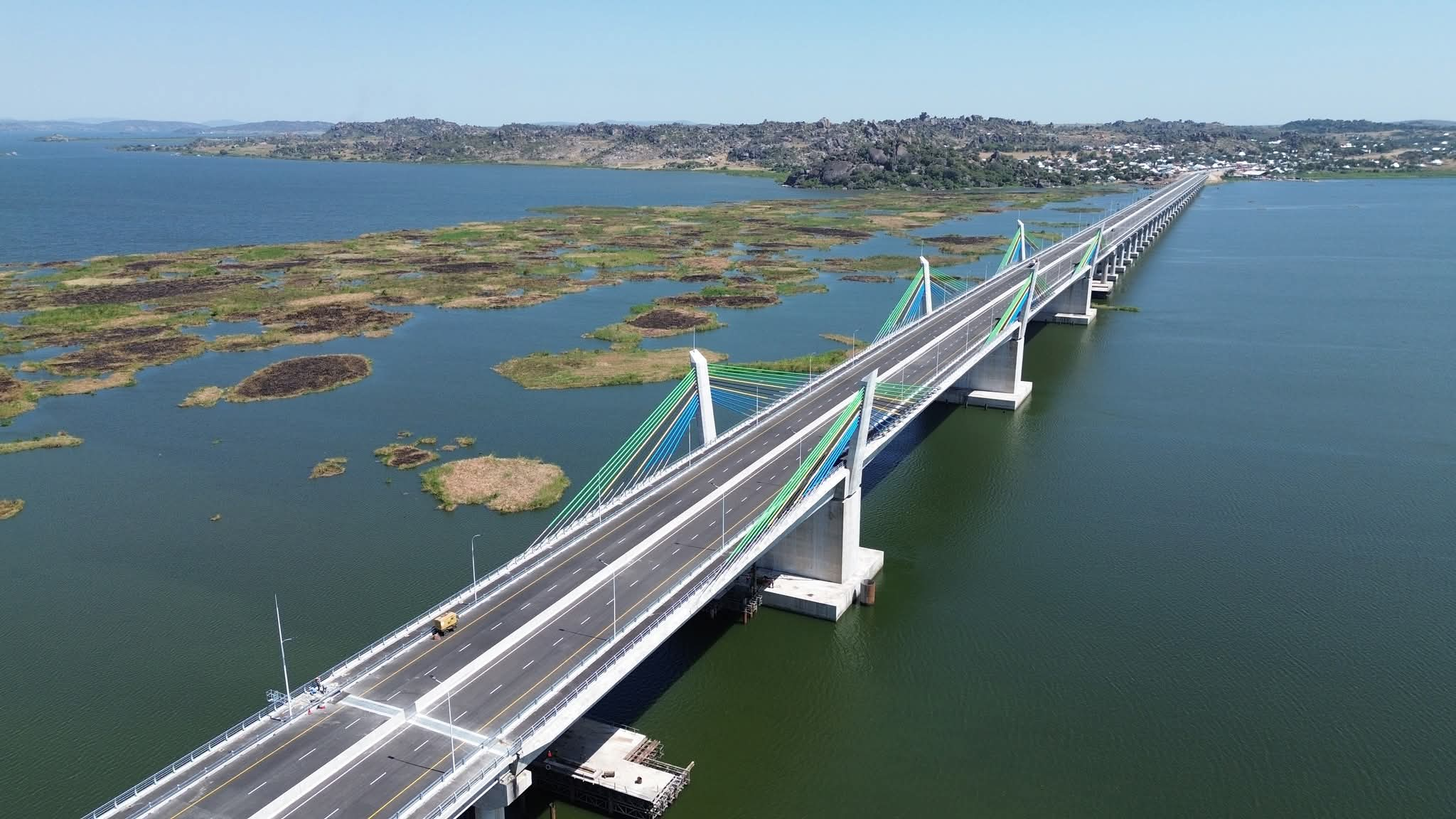BALTIMORE: 10 Facts to know about the Francis Scott Key Bridge

Did you know that the Francis Scott Key Bridge (Baltimore) collapse on March 26, 2024, is expected to trigger one of the largest marine losses in history, according to the Lloyd’s of London, and that the total length was 8,636 feet (2,632 m) long?
The Francis Scott Key Bridge (Baltimore) in the United States was a steel arch continuous through truss bridge that spanned the lower Patapsco River and outer Baltimore Harbor / Port carrying the Baltimore Beltway (Interstate 695 or I-695) between Hawkins Point, an isolated southern neighborhood of Baltimore, and Dundalk in Maryland. The main spans of the bridge, on March 26, 2024, at 01:27 EDT (05:27 UTC), collapsed after the Singapore-registered container ship MV Dali lost power and collided with the southwest supporting pier of the main truss section. The collapse was declared a "mass casualty incident".
Here are some facts to know about the bridge:
FACT 1: The bridge was named in 1976 to honor Francis Scott Key, the author of "The Defense of Fort M'Henry," the poem upon which "The Star-Spangled Banner" is based. Key was inspired to write the poem after witnessing the bombardment of Fort McHenry during the Battle of Baltimore in September 1814.
FACT 2: Another similarly-named Francis Scott Key Bridge crosses the Potomac River in Washington, D.C.
FACT 3: The bridge project was financed by a $220 million bond issue (equivalent to $1.9 billion in 2023) alongside the twinning of the Chesapeake Bay Bridge in October 1968. Bids for constructing the proposed Outer Harbor Tunnel were opened in July 1970, but price proposals were substantially higher than the engineering estimates. Officials drafted alternative plans, including a four-lane bridge, which the General Assembly approved in April 1971.
FACT 4: The United States Coast Guard issued its bridge permit in June 1972, replacing an earlier approval of the tunnel from the Army Corps of Engineers. Construction of the Outer Harbor Bridge began in 1972, several years behind schedule and $33 million over budget.

FACT 5: Baltimore engineering firm, J. E. Greiner Company, was selected as the primary design consultant, with only the side approaches being handled by New York City's Singstad, Kehart, November & Hurka in joint venture with Baltimore Transportation Associates, Inc. Construction was performed by the John F. Beasley Construction Company with material fabricated by the Pittsburgh-Des Moines Steel Co.
FACT 6: The Key Bridge opened to traffic on March 23, 1977. Including its connecting approaches, the bridge project was 1.6 miles (2.57 km) in length with 8.7 miles (14.00 km) of approach road. The bridge opened with four lanes, but its approaches were two lanes to reduce costs. The south approach was widened in 1983. A project for the north approach was completed in 1999 after several years of delays.
FACT 7: In 1978, the bridge received an Award of Merit from the American Institute of Steel Construction in the Long Span category. A few months after the 1980 Sunshine Skyway Bridge collapse, a cargo ship collided with the Key Bridge, but the bridge was relatively undamaged.
FACT 8: The bridge main span of 1,200 feet (366 m) was the third longest span of any continuous truss in the world, and the total length was 8,636 feet (2,632 m) long. It was the second-longest bridge in the Baltimore metropolitan area, after the Chesapeake Bay Bridge.
FACT 9: There was a eight-worker repair crew working on the bridge at the time of the collision. It is believed the crew are the only victims in the disaster. Rescue divers found two of the victims below 25 feet of Patapsco River water inside a red pickup truck, near the mid-span of the wreckage.
FACT 10: In the aftermath of the bridge collapse, insurers are expected to incur multi-billion dollar losses for the damages, business disruptions, and liability claims. Insurance claims for damage to the bridge alone could reach $1.2 billion, according to Barclays Plc, predicting further potential liabilities of $350 million to $700 million for wrongful deaths and yet-to-be-determined amounts for business interruptions while access to the city’s port is blocked.
Sources: Fortune | Wikipedia
#penglobalfactfile #Baltimore


_1755775186.jpg)
